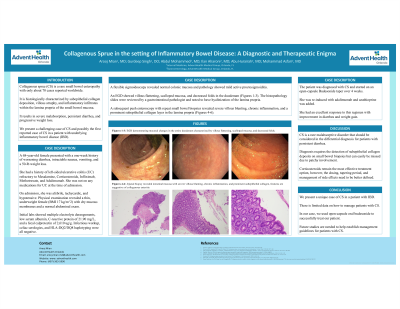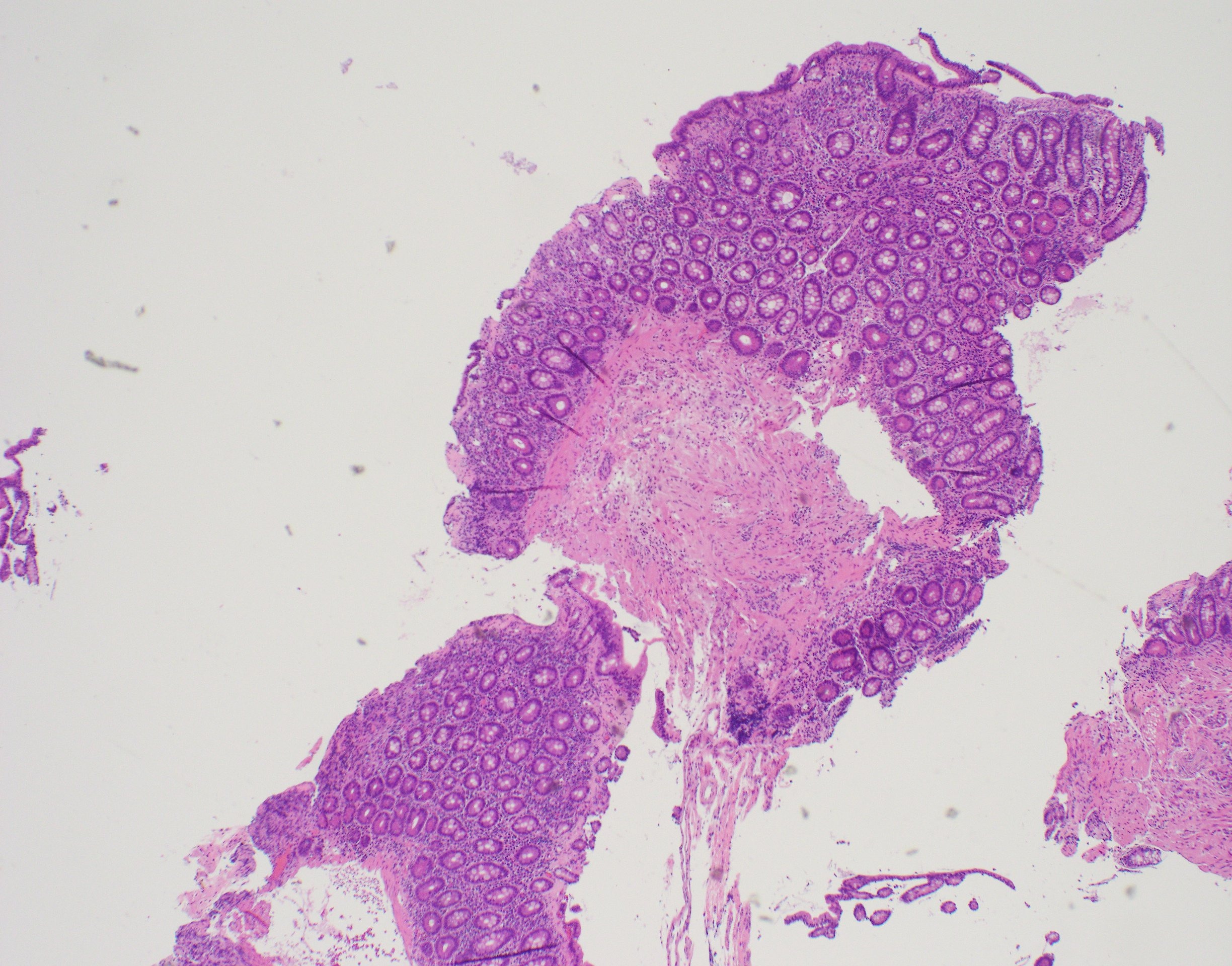Tuesday Poster Session
Category: Small Intestine
P4131 - Collagenous Sprue in the Setting of Inflammatory Bowel Disease: A Diagnostic and Therapeutic Enigma
Tuesday, October 24, 2023
10:30 AM - 4:00 PM PT
Location: Exhibit Hall

Has Audio

Arooj Mian, MD
AdventHealth
Orlando, FL
Presenting Author(s)
Arooj Mian, MD1, Gurdeep Singh, DO1, Abdul Mohammed, MD1, Ilan Aharoni, MD2, Mohammad Asfari, MD1, Abu Hurairah, MD1
1AdventHealth, Orlando, FL; 2AdventHealth, Winter Park, FL
Introduction: Collagenous sprue (CS) is a rare small bowel enteropathy with only about 70 cases reported worldwide. It is histologically characterized by subepithelial collagen deposition, villous atrophy, and inflammatory infiltrates within the lamina propria of the small bowel mucosa. It results in severe malabsorption, persistent diarrhea, and progressive weight loss. We present a challenging case of CS and possibly the first reported case of CS in a patient with underlying inflammatory bowel disease (IBD).
Case Description/Methods: A 68-year-old female presented with a one-week history of worsening diarrhea, intractable nausea, vomiting, and a 50-lb weight loss. She had a history of left-sided ulcerative colitis (UC) refractory to various medical therapies including Mesalamine, Corticosteroids, Infliximab, Methotrexate, and Adalimumab. She currently was not on any medications for UC. On admission, she was afebrile, tachycardic, and hypotensive. Physical examination revealed a thin, underweight female (BMI 17 kg/m^2) with dry mucous membranes and a normal abdominal exam. Initial labs showed severe electrolyte abnormalities, low serum albumin, C-reactive protein 21.90 mg/L, and fecal calprotectin 2,610 ug/g. Infectious work up, celiac serologies, and HLA-DQ2/DQ8 haplotyping were all negative. A flexible sigmoidoscopy revealed normal colonic mucosa and pathology showed mild active proctosigmoiditis. An esophagogastroduodenoscopy (EGD) showed villous flattening, scalloped mucosa, and decreased folds in the duodenum. The histopathology slides were reviewed by a gastrointestinal pathologist and noted to have hyalinization of the lamina propria. A subsequent push enteroscopy with repeat small bowel biopsies revealed severe villous blunting, chronic inflammation, and a prominent subepithelial collagen layer in the lamina propria. The patient was diagnosed with CS and started on a Budesonide taper over 4 weeks. She was re-induced with adalimumab and azathioprine was added. She had an excellent response to this regimen with improvement in diarrhea and weight gain.
Discussion: CS is a rare malabsorptive disorder that should be considered in the differential diagnosis for patients with persistent diarrhea. Diagnosis requires detection of subepithelial collagen deposits on small bowel biopsies but can easily be missed due to patchy involvement. Corticosteroids remain the most effective treatment option, however, the dosing, tapering period, and management of side-effects need to be better defined.

Disclosures:
Arooj Mian, MD1, Gurdeep Singh, DO1, Abdul Mohammed, MD1, Ilan Aharoni, MD2, Mohammad Asfari, MD1, Abu Hurairah, MD1. P4131 - Collagenous Sprue in the Setting of Inflammatory Bowel Disease: A Diagnostic and Therapeutic Enigma, ACG 2023 Annual Scientific Meeting Abstracts. Vancouver, BC, Canada: American College of Gastroenterology.
1AdventHealth, Orlando, FL; 2AdventHealth, Winter Park, FL
Introduction: Collagenous sprue (CS) is a rare small bowel enteropathy with only about 70 cases reported worldwide. It is histologically characterized by subepithelial collagen deposition, villous atrophy, and inflammatory infiltrates within the lamina propria of the small bowel mucosa. It results in severe malabsorption, persistent diarrhea, and progressive weight loss. We present a challenging case of CS and possibly the first reported case of CS in a patient with underlying inflammatory bowel disease (IBD).
Case Description/Methods: A 68-year-old female presented with a one-week history of worsening diarrhea, intractable nausea, vomiting, and a 50-lb weight loss. She had a history of left-sided ulcerative colitis (UC) refractory to various medical therapies including Mesalamine, Corticosteroids, Infliximab, Methotrexate, and Adalimumab. She currently was not on any medications for UC. On admission, she was afebrile, tachycardic, and hypotensive. Physical examination revealed a thin, underweight female (BMI 17 kg/m^2) with dry mucous membranes and a normal abdominal exam. Initial labs showed severe electrolyte abnormalities, low serum albumin, C-reactive protein 21.90 mg/L, and fecal calprotectin 2,610 ug/g. Infectious work up, celiac serologies, and HLA-DQ2/DQ8 haplotyping were all negative. A flexible sigmoidoscopy revealed normal colonic mucosa and pathology showed mild active proctosigmoiditis. An esophagogastroduodenoscopy (EGD) showed villous flattening, scalloped mucosa, and decreased folds in the duodenum. The histopathology slides were reviewed by a gastrointestinal pathologist and noted to have hyalinization of the lamina propria. A subsequent push enteroscopy with repeat small bowel biopsies revealed severe villous blunting, chronic inflammation, and a prominent subepithelial collagen layer in the lamina propria. The patient was diagnosed with CS and started on a Budesonide taper over 4 weeks. She was re-induced with adalimumab and azathioprine was added. She had an excellent response to this regimen with improvement in diarrhea and weight gain.
Discussion: CS is a rare malabsorptive disorder that should be considered in the differential diagnosis for patients with persistent diarrhea. Diagnosis requires detection of subepithelial collagen deposits on small bowel biopsies but can easily be missed due to patchy involvement. Corticosteroids remain the most effective treatment option, however, the dosing, tapering period, and management of side-effects need to be better defined.

Figure: Jejunum, biopsy: Intestinal mucosa with severe villous blunting, chronic inflammation, and prominent subepithelial collagen.
Disclosures:
Arooj Mian indicated no relevant financial relationships.
Gurdeep Singh indicated no relevant financial relationships.
Abdul Mohammed indicated no relevant financial relationships.
Ilan Aharoni indicated no relevant financial relationships.
Mohammad Asfari indicated no relevant financial relationships.
Abu Hurairah indicated no relevant financial relationships.
Arooj Mian, MD1, Gurdeep Singh, DO1, Abdul Mohammed, MD1, Ilan Aharoni, MD2, Mohammad Asfari, MD1, Abu Hurairah, MD1. P4131 - Collagenous Sprue in the Setting of Inflammatory Bowel Disease: A Diagnostic and Therapeutic Enigma, ACG 2023 Annual Scientific Meeting Abstracts. Vancouver, BC, Canada: American College of Gastroenterology.
